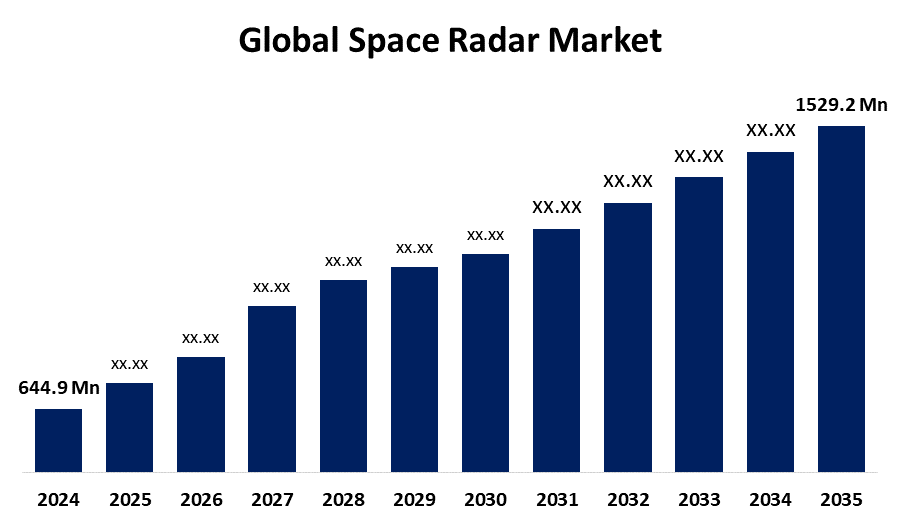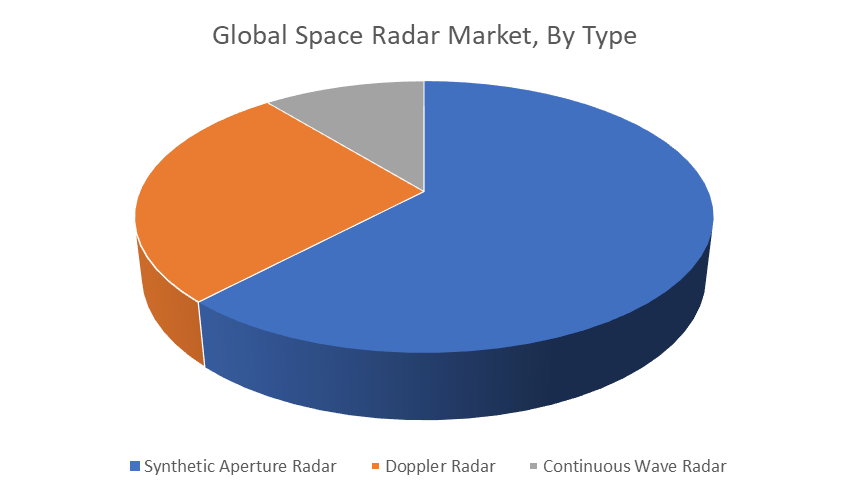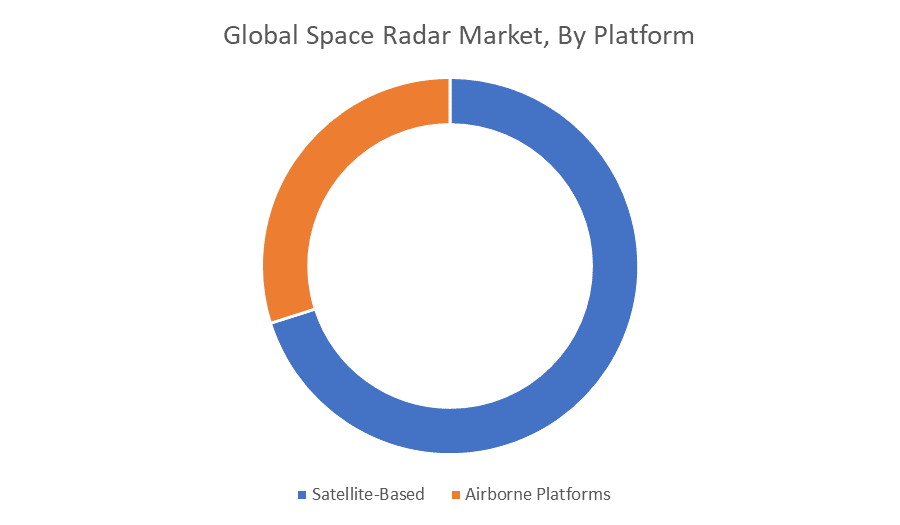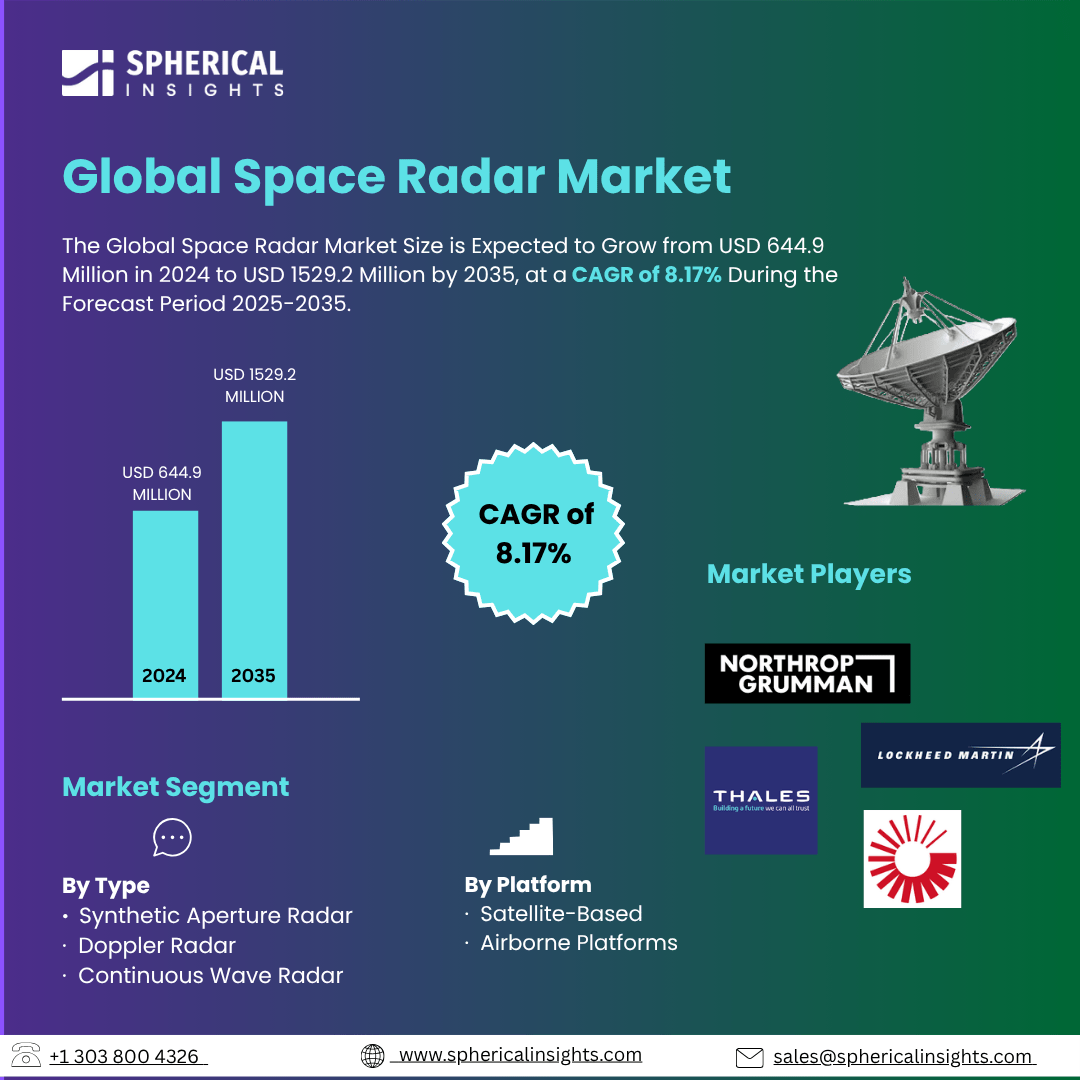Global Space Radar Market Insights Forecasts To 2035
- The Global Space Radar Market Size Was Estimated at USD 644.9 Million in 2024
- The Market Size is Expected to Grow at a CAGR of around 8.17% from 2025 to 2035
- The Worldwide Space Radar Market Size is Expected to Reach USD 1529.2 Million by 2035
- Asia Pacific is Expected to Grow the fastest during the forecast period.

Space Radar Market
The space radar market encompasses radar systems deployed on satellites and spacecraft, primarily utilizing technologies like Synthetic Aperture Radar (SAR) for earth observation, environmental monitoring, and defense surveillance. These systems enable high-resolution imaging capabilities regardless of weather conditions or lighting, making them essential for a wide range of applications. The market is characterized by increasing adoption of satellite-based radar systems, with a significant focus on X-band and C-band frequencies due to their precision and versatility. SAR technology, in particular, plays a dominant role owing to its ability to capture detailed images from space. Space radar platforms are widely used in defense, scientific research, and commercial sectors, offering global coverage and long-term monitoring capabilities. With ongoing advancements in radar imaging and satellite miniaturization, the market is evolving rapidly, marked by a shift toward constellations of small satellites. The overall industry continues to expand, aligning with broader trends in space-based technologies and earth observation.
Attractive Opportunities in the Space Radar Market
- With the increasing number of satellites and space missions, managing orbital traffic and tracking space debris is becoming critical. Space radar systems can provide precise monitoring to prevent collisions and ensure safer space operations.
- Radar-equipped spacecraft offer valuable capabilities for planetary mapping, asteroid detection, and lunar surface analysis, supporting upcoming missions and expanding scientific knowledge beyond Earth orbit.
- Radar can be applied to track illegal fishing, monitor maritime activities, and oversee environmental conditions in remote or difficult-to-access regions like the Arctic.
- As concerns grow about sustainability in low Earth orbit, radar technology will be vital for monitoring space environmental impacts, including debris management and satellite health.
Global Space Radar Market Dynamics
DRIVER: The increasing demand for advanced earth observation
The growth of the space radar market is primarily driven by the increasing demand for advanced earth observation and surveillance capabilities across defense, environmental, and commercial sectors. Rising geopolitical tensions and the need for continuous, real-time intelligence are fueling investments in satellite-based radar systems, especially for defense and security applications. Technological advancements in Synthetic Aperture Radar (SAR), including higher resolution imaging and data processing, are enabling more accurate and comprehensive monitoring. Additionally, the growing adoption of small satellites and satellite constellations allows for more frequent and cost-effective data collection. Climate change monitoring, disaster management, and agricultural planning are also contributing to market expansion, as radar satellites offer consistent imaging regardless of weather or lighting conditions. The integration of space radar data with artificial intelligence and geospatial analytics further enhances its value for decision-making. Governments and private entities are increasingly investing in space radar infrastructure, reinforcing the market's upward trajectory worldwide.
RESTRAINT: Challenging for startups and budget-constrained governments to participate
A major barrier is the substantial investment required to design, launch, and operate space-based radar systems, making it challenging for startups and budget-constrained governments to participate. The technology’s complexity demands a highly skilled workforce and specialized infrastructure, which are not readily available in all regions. Additionally, managing electromagnetic spectrum allocations and navigating international space regulations can delay deployment and complicate operations. Concerns over data ownership and national security also limit access to high-resolution radar imagery, especially for non-military or commercial users. Furthermore, technical challenges such as signal noise, atmospheric interference, and the need for large volumes of onboard data processing reduce system efficiency. The reliance on successful satellite launches and the risks associated with space debris add another layer of uncertainty. These factors collectively create entry barriers and operational constraints that can slow market adoption and expansion.
OPPORTUNITY: Growing interest in space traffic management and debris tracking
One key area is the growing interest in space traffic management and debris tracking, where radar systems can play a critical role in monitoring space objects and ensuring the safety of orbital operations. There is also increasing potential in deep space exploration, where radar-equipped spacecraft can support planetary mapping, asteroid detection, and lunar surface analysis. Another opportunity lies in cross-sector integration—combining space radar data with other technologies like IoT, blockchain, and edge computing to enhance real-time analytics and decision-making. The commercialization of space, led by private players and space tourism ventures, also opens new applications for radar systems in launch monitoring and mission safety. Furthermore, the potential use of radar for maritime domain awareness, illegal fishing detection, and Arctic surveillance presents new avenues for growth. As sustainability in space gains momentum, radar will become vital for monitoring environmental impacts in low Earth orbit.
CHALLENGES: Vast amounts of data generated by radar systems pose significant challenges in terms of storage
The vast amounts of data generated by radar systems pose significant challenges in terms of storage, real-time processing, and analysis, particularly for organizations lacking advanced data infrastructure. Cybersecurity is another emerging concern, as radar satellites and their ground control systems become potential targets for cyberattacks and data breaches. Intellectual property disputes and competition over proprietary radar technologies may also hinder collaboration and innovation. Moreover, the unpredictable nature of space environments—such as radiation exposure and mechanical wear from micro-meteoroids—can affect radar satellite performance and longevity. Lastly, political tensions and export control regulations may limit international cooperation and the global sharing of radar capabilities, potentially slowing the development and adoption of advanced radar solutions across borders.
Global Space Radar Market Ecosystem Analysis
The global space radar market includes many groups working together. Some companies make radar parts, others build and launch satellites carrying these radars into space. Experts put all the parts together so they work well. Many users, like the military, scientists, and businesses, use radar data to watch the Earth, track weather, and help during disasters. Governments and organizations make rules to keep space safe and support new ideas. All these groups form a system that helps space radar technology grow and improve.
Based on the type, the synthetic aperture radar segment dominated the space radar market over the forecast period

The synthetic aperture radar segment dominated the space radar market over the forecast period. This is because SAR technology provides high-resolution, all-weather, day-and-night imaging capabilities, making it highly effective for Earth observation, defense surveillance, and environmental monitoring. Its ability to capture detailed images through clouds and darkness gives it a significant advantage over other radar types, driving its strong market presence and continued demand.
Based on the platform, the satellite-based segment dominated the space radar market over the forecast period

The satellite-based segment dominated the space radar market over the forecast period. Satellite platforms offer wide-area coverage and continuous monitoring capabilities, making them ideal for applications like earth observation, defense surveillance, and environmental monitoring. Their ability to operate in space allows for consistent, all-weather data collection across large geographic areas, which drives the strong demand and market dominance of satellite-based radar systems.
North America is anticipated to hold the largest market share of the space radar market during the forecast period
North America is anticipated to hold the largest market share of the space radar market during the forecast period. This leadership is driven by the region’s strong presence of key radar technology developers, advanced space programs, and substantial defense spending. The United States, in particular, invests heavily in satellite-based radar systems for military surveillance, intelligence, and environmental monitoring. Additionally, North America benefits from robust infrastructure, ongoing technological innovations, and collaborations between government agencies and private space companies, all of which contribute to its dominant position in the global space radar market.
Asia Pacific is expected to grow at the fastest CAGR in the space radar market during the forecast period
Asia Pacific is expected to grow at the fastest CAGR in the space radar market during the forecast period. This rapid growth is fueled by increasing investments in space technology, expanding defense budgets, and growing adoption of satellite-based radar systems in countries like China, India, and Japan. The region is also witnessing rising government initiatives to enhance earth observation and disaster management capabilities. Additionally, the emergence of private space companies and advancements in radar technology contribute to the dynamic expansion of the space radar market in Asia Pacific.
Recent Development
- In March 2024, ICEYE launched three new Synthetic Aperture Radar (SAR) satellites, including a 1200 MHz radar bandwidth on-orbit technology demonstrator capable of 25 cm imaging. The launch was part of SpaceX's Transporter-10 rideshare mission from Vandenberg Space Force Base, California.
Key Market Players
KEY PLAYERS IN THE SPACE RADAR MARKET INCLUDE
- Northrop Grumman Corporation
- Raytheon Technologies Corporation
- Lockheed Martin Corporation
- Thales Group
- Airbus Defence and Space
- ICEYE
- Synspective
- LeoLabs
- Mitsubishi Electric Corporation
- Ball Aerospace
- Others
Market Segment
This study forecasts revenue at global, regional, and country levels from 2020 to 2035. Spherical Insights has segmented the space radar market based on the below-mentioned segments:
Global Space Radar Market, By Type
- Synthetic Aperture Radar
- Doppler Radar
- Continuous Wave Radar
Global Space Radar Market, By Platform
- Satellite-Based
- Airborne Platforms
Global Space Radar Market, By Regional Analysis
- North America
- Europe
- Germany
- UK
- France
- Italy
- Spain
- Russia
- Rest of Europe
- Asia Pacific
- China
- Japan
- India
- South Korea
- Australia
- Rest of Asia Pacific
- South America
- Brazil
- Argentina
- Rest of South America
- Middle East & Africa
- UAE
- Saudi Arabia
- Qatar
- South Africa
- Rest of the Middle East & Africa






